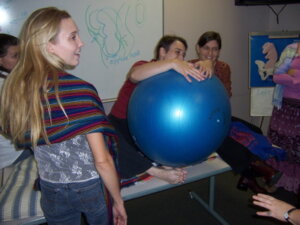Can Spinning Babies be used with an epidural?
“I put many of the techniques taught during Friday’s class into practice today. The momma I was waiting for last week was induced today. She got an epidural before I arrived. Used the peanut ball with knee in and down, SLR, hands and knees, and within minutes we were pushing. Everyone was shocked how fast baby moved… ha, I wasn’t.”
Cheryl Neel, CD(DONA)
www.doulawithTLC.com
 Here’s a picture (right) from an earlier Austin, Texas Spinning Babies Workshop. This unusual labor progress technique was shared by Dr. Diane Peterson, OB..
Here’s a picture (right) from an earlier Austin, Texas Spinning Babies Workshop. This unusual labor progress technique was shared by Dr. Diane Peterson, OB..
Purpose: Engage the Baby into the pelvis when mother is on an epidural and can’t stand up for the Abdominal Lift and Pelvic Tilt.
Gail was a doula at a birth in Minneapolis, long ago before the knowledge of Sidelying Release, when Dr. Diane suggested we help baby move down into the pelvis by draping the determined mother over a ball and having her rock in a wide, and circular motion between the nurse and myself. We kept her from coming off the end of the hospital bed due to the extreme circling.
See how the mother would place the birth ball between her crossed legs? The circles could be dehttps://www.spinningbabies.com/wp-content/uploads/2019/10/sample3-1.pngd as wide and vigorous but not as fast as Salsa. One hip rises off the bed on the opposite side from the furthest arc of the circle (the direction she leans). After 40 minutes, Dr. Diane checked the baby’s progress again. Baby was in the pelvis at last.
Epidural use is common in the technological birth care model. While usually providing the best pain relief, the side effects of injecting narcotics between the membranes coating the spine may lead to more interventions. Pitocin augmentation and cesarean section are increased. Our goal is to reduce unwanted side-effects and their interventions with physiological techniques and emotional support.
I believe that epidural side effects may be reduced by doing Sidelying Release and other body balancing actions first. The relief from myofascial body work before and labor may potentially eliminate the woman’s desire for an epidural since pain relief by natural means may now be sufficient.
When a woman has an epidural, many of our favorite techniques can be used when baby’s position is not ideal and/or labor progress is slow. Nurses have even told me they do Forward Leaning Inversion (only during and between 3 contractions per inversion). These innovative care givers help the mom into an “elbows and knees position” facing the foot of the bed and then lower the foot section of the bed so the birthing woman’s head is lower than her knees. Steep inversion may help the cervix dilate easier afterwards. Follow up by resting on the left side and placing the peanut ball between her thighs and calves.
Later Cheryl added, “During a postpartum visit I had with this momma, she commented (without prompting), how she felt during SLR and had the biggest smile. When describing how she felt on hands and knees, she said, ‘That’s when, even with the epidural, I felt the baby move and come down out of my pelvis.’ With all of the medical stuff that was going on with low blood pressure and heart tones, etc, I feel like spinning babies saved this family from a C-Ssec. Powerful stuff.”
